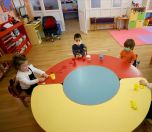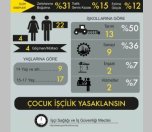* Photo: Pixabay
Click to read the article in Turkish
The Turkish Statistical Institute (TurkStat) released the results of its "Child Labor Survey" after an interval of seven years today (March 31).
According to the survey, the number of children engaged in economic activities in the 5-17 age group in Turkey is 720 thousand.
In the latest "Working Child Statistics" shared by the Institute in 2012, it was indicated that children at the ages of 6-17 constituted 20.6 percent of the total population and 893 thousand of 15 million 247 thousand children were engaged in economic activities.
CLICK - TurkStat Not Conducted Child Labor Survey For Seven Years
The Ministry of Labor and Social Security developed a "National Program for Struggle Against Child Labor" and declared 2018 "the Year of Struggle Against Child Labor" to prevent child labor.
The latest research released by the TurkStat includes differences in terms of scope and methodology with the previously conducted surveys.
The Institute has accounted for these differences in following words: "These differences are the arrangements in 2014 Household Labour Force Survey structure and the inclusion of the 5-17 age group on working child statistics of the International Labour Organization. The term 'working child' in this press release refers to 'children engaged in economic activities'."
Within the frame, the TurkStat has shared the following statistics on child labor in the country after seven years:
No 5-year-old children among child laborers
According to the statistics of the Institute, the number of children in the 5-17 age group is estimated at 16 million 457 thousand. Children in this age group are 20.3 percent of the non-institutional population.
By age groups, the number of children in the 5-11 age group is estimated as 9 million 12 thousand while 3 million 796 thousand are estimated in the 12-14 age group and 3 million 649 thousand children in the 15-17 age group.
The number of children engaged in economic activities is 720 thousand and no 5-year-old child is observed among them. Employment rate which shows the proportion of working children in the 5-17 age group among children in the same age group is estimated at 4.4 percent.
79.7 percent in the 15-17 age group
While 79.7 percent of working children are in the 15-17 age group, 15.9 percent are in the 12-14 age group and 4.4 percent are in the 5-11 age group. When examined by gender, it ,s seen that 70.6 percent of working children are boys and 29.4 percent are girls.
65.7 percent also continue their education
While 65.7 percent of working children attend an education, this rate is 65.6 percent for boys and 66.1 percent for girls. According to age groups; 72 percent of working children in the 5-14 age group and 64.1 percent of working children in the 15-17 age group also continue an education. 34.3 percent of working children do not continue their education.
When the reason of working for children engaged in economic activities are listed; "to help in household's economic activity" was the first place with 35.9 percent, and others are "to learn a profession and skills for a job" with 34.4 percent, "to contribute household income" with 23.2 percent and "to support his/her needs" with 6.4 percent.
30.8 percent work in agriculture
While 30.8 percent of working children take part in agriculture, 23.7 percent is in industry and 45.5 percent in service sector. According to age groups; children working in the 5-14 age group gain weight in the agricultural sector with 64.1 percent while children working in the 15-17 age group gain weight in the service sector with 51 percent.
36.2 percent unpaid family workers
63.3 percent of working children work as regular or casual employees while 36.2 percent of them work as unpaid family workers and 0.5 percent of them are self-employed.
By workplace, 66 percent of the working children is at regular/fixed workplaces, 30.4 percent of them work in the field/garden, 3 percent of them work in the mobile, irregular or market place and 0.5 percent work at home.
Extreme hot/cold, chemicals, heavy loads...
When the factors that negatively affect physical health are examined in the workplace; 12.9 percent of working children work in an extremely hot/cold or in an excessive humidity/no humidity environment, 10.8 percent of them is exposed to chemicals, dust, fumes, smoke or gases, 10.1 percent of them to difficult work postures or movements and handling heavy loads and 10 percent is exposed to noise or strong vibrations.
It is determined that 6.4 percent of working children face the risk of accidents in their workplace and 4.6 percent of them is at risk for eye strain and visual concentration in their workplace.
1.3 percent had injuries at their workplace
While 1.3 percent were exposed to "any injuries" at their workplace, 4.4 percent of them have witnessed "any injuries" at their workplace.
CLICK - At Least 26 Child Workers Lose Their Lives in the First Five Months of 2019
The rate of those who experienced "any discomfort arising from the working conditions in the workplace" is 0.6 percent while the rate of those who witnessed this situation is 2.2 percent. While 0.1 percent of working children were exposed to physical, verbal violence or unpleasant behavior at their workplace, the rate of those witnessed this situation is 1.5 percent.
45.5 percent contribute to household chores
Children who help their families with household chores such as shopping, cleaning, cooking, ironing, etc. or caring younger children or an elderly/disabled/ill persons in the household, refer to children supporting their families. They are not covered by the working child.
In this context, 45.5 percent of children in the 5-17 age group contribute to their families in any of the household chores. This rate is 40.0 percent for boys and 51.3 percent for girls.
While 43.5 percent of the children help their families with household chores in "shopping for households, laundry-dishwashing, ironing, cooking, cleaning of household items", 23.2 percent assist their family in "caring for younger children in the household" and 5.4 percent help their family in "caring for elderly/disabled/ill person in the household".
Girls spend more time on household chores
Children contributing to their families in household chores spent 5.8 hours on average in reference week. While 40.2 percent of the children who help their families with household chores spent 2 hours and less on household chores in the reference week, 37 percent of them was 3-7 hours, 14.5 percent of them was 8-14 hours, 5.4 percent of them spent 15-20 hours, 3 percent of them spent 21 hours or more in the reference week.
When examined by gender; girls are observed to spend more time on household chores. 16.3 percent of boys and 28.3 percent of girls contribute to housework 8 hours or more in a week. (AÖ/SD)










-132.jpg)


